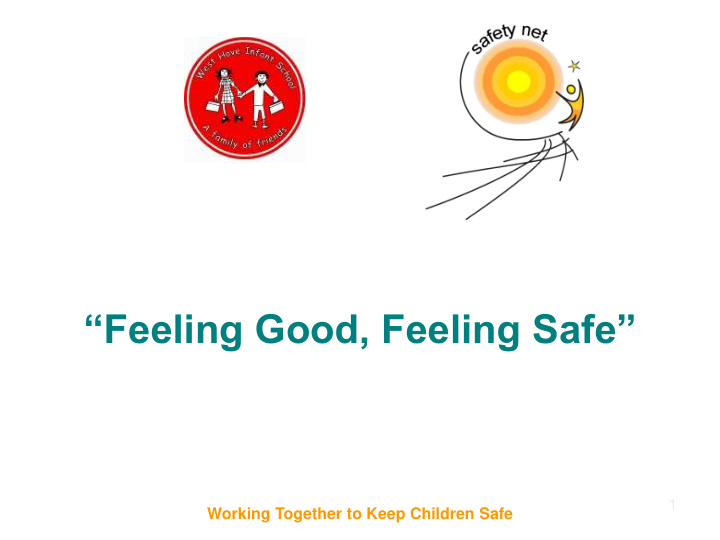



“Feeling Good, Feeling Safe” 1 Working Together to Keep Children Safe
Background West Hove Infant School has worked with BHCC and Safety Net to further develop our PSHE materials in line with the Protective Behaviours programme Working Together to Keep Children Safe 2
What is Feeling Good, Feeling Safe? A Safety Programme for children based on Protective Behaviours. It can be used to help children to feel and keep safe in different situations by developing safety knowledge, tools and skills. 3 Working Together to Keep Children Safe
The Two Themes “ We all have the Right to Feel Safe all of the Time” “We can talk with someone about anything, even if it feels awful or small” Working Together to Keep Children Safe 4
A whole school approach 1. Safety Lessons for : children 2. Reinforcement of ideas across the school setting 3. Involvement of parents and carers 5 Working Together to Keep Children Safe
Programme Content All All ch chil ildr dren en wil will l be be lear learning ning about: about: 1. Feelings & Feeling Safe 2. Feeling Unsafe & early Warning signs 3. Body Awareness & secrets 4. How to get help & problem-solving 6 Working Together to Keep Children Safe
Rules vs Learning skills Rules can be useful but don’t work in all situations Protective Behaviours is about teaching children to recognise their own internal warning signs about when they feel safe and unsafe identify who they can talk to if they feel worried or unsafe in different situations Practicing what to do to keep safe in different situations Working Together to Keep Children Safe
Benefits for the school • A common language for everyone to use in managing issues • Children who feel ‘safe’ are likely to be able to learn more easily • Improvements in pupil behaviour • Supports school strategy for dealing with bullying and safeguarding Working Together to Keep Children Safe
The 4 Lessons 9 Working Together to Keep Children Safe
Lesson 1: Develop self-esteem Manage feelings Confidence to learn and try new things Ability to help others feel safe 10
Help us to understand our feelings We need words for our feelings, sad and happy. Its important to talk about our feelings. It’s ok to feel whatever we feel, but it’s not always ok to act on it.
When do you feel safe? Help children to • Help children to understand: understand: • what safe feels what Safe feels like for them like for them • what helps them what helps them to feel safe and to feel safe and • identify safe identify safe places for them places for them
Lesson 2: Feeling Unsafe My Early Warning Signs are: Butterflies in my stomach, heart beats really fast, you get a headache, wobbly knees, feel sick, cant move, hair stands on end Our bodies are clever, they tell us when we are feeling unsafe
It’s good to take a risk on purpose It’s how we learn and grow!
Lesson 3: Body Awareness & Secrets What’s Missing? Why is it important that children can name all of their body parts?
Lesson 4: How to get help and problem-solving
Helping Hands Children can use their Helping Hand as a way of remembering who they can talk to when they don’t feel safe. Children choose the adults to put on their Helping Hand one for each finger and people at home on the thumb.
Making Safer Choices STOP How do I feel? THINK What are my options? GO The best/safest choice for me? Working Together to Keep Children Safe
Recommend
More recommend